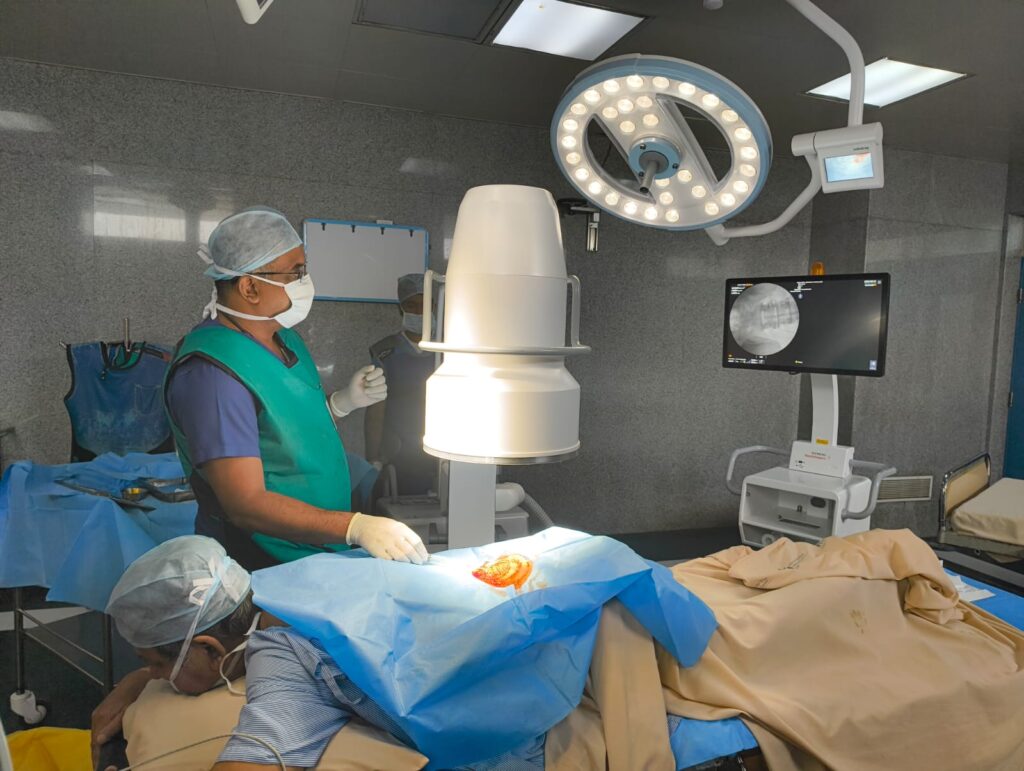What is a Nerve Root Block?
A nerve root block is a medical procedure where a combination of local anesthetic and steroid is injected under X-ray guidance into the area where a nerve exits the spinal column. This treatment is typically recommended for patients experiencing pain in the arms or legs that follows the pathway of a specific nerve. It can serve both diagnostic and therapeutic purposes: helping to identify the source of pain and providing relief. If patients experience significant pain relief from the initial injection, it may be repeated. Additionally, nerve root blocks can aid in determining the necessity and optimal level for potential surgical interventions.
Important Note: This procedure cannot be performed if you have an active infection, flu, cold, fever, extremely high blood pressure, or if you are taking blood thinners. It’s crucial to inform your doctor about any of these conditions to ensure your safety.

Preparing for Your Procedure
- Fasting: You should refrain from solid foods and fluids after midnight before the procedure unless instructed otherwise. However, you may take your medications with a small amount of water.
- Diabetes Management: If you are diabetic, avoid taking your diabetes medication until after the procedure is completed. Be sure to check your blood sugar levels at home before arriving.
- Blood Thinners: If you are on blood thinners (such as Coumadin, Warfarin, or Plavix), these medications should be discontinued well in advance of the procedure. Follow your doctor’s guidance on when to stop these medications.
Risks Associated with the Procedure
As with any medical procedure, there are potential risks, albeit rare, including:
- Bleeding
- Infection
- Nerve injury
- Allergic reactions to the medications used
Possible short-term side effects may include:
- Numbness along the path of the blocked nerve
- Temporary weakness (if this affects your mobility, you may need to remain at the Pain Management Center until it resolves)
- Increased pain for a few days following the injection, including localized discomfort at the injection site
- Temporary elevation of blood sugar levels in diabetics due to the steroid medication
What to Expect During the Injection
- Consent and Monitoring: After signing a consent form and having your vital signs checked, the procedure will take place in the fluoroscopy (X-ray) room while you lie on your stomach.
- Intravenous (IV) Access: An IV line may be placed in your hand or arm to provide fluids and medication to help you relax.
- Preparation of the Area: Your back will be cleansed with antiseptic soap, and sterile drapes will be placed around the area.
- Numbing the Skin: A local anesthetic will be applied to numb the skin, which may cause brief stinging or burning.
- Needle Insertion: Using X-ray guidance, a needle will be carefully advanced to the target location. A contrast dye may be injected at this stage (please inform your doctor if you have allergies to X-ray dye or shellfish).
- Injection of Medication: A mixture of local anesthetic and steroid will be injected through the needle, which is then removed. The area will be cleansed, and a Band-Aid will be applied (this can be removed the following morning).
- Recovery Monitoring: Your blood pressure will be monitored for about 20-30 minutes in the recovery area, and you may be offered juice and graham crackers.
- Discharge Instructions: You will receive both written and verbal discharge instructions, and you may go home with a responsible adult once authorized by your doctor.
Post-Injection Expectations
- Immediate Pain Relief: You may notice some pain relief right after the injection due to the local anesthetic.
- Steroid Effects: The steroid typically takes 2-3 days to start working, with peak effectiveness usually occurring around two weeks post-injection.
- Local Tenderness: Some tenderness may occur for a few days after the injection; applying an ice pack 3-4 times daily can help alleviate discomfort.
- Pain Medication: You can take your regular pain medications following the injection. It’s essential to monitor the level of pain relief and how long it lasts.
Restrictions Following the Procedure
- Driving: You will not be allowed to drive for the rest of the day. A responsible adult (over 18) must accompany you home.
- Safety Precaution: If you do not have an adult to drive you, the procedure will be canceled for your safety.
- Post-Procedure Care: Avoid using heat on the injected area for the rest of the day, and do not take tub baths, showers, or soak in water (e.g., pools, hot tubs).
- Diet and Medications: You may resume your normal diet and medications unless otherwise directed by your doctor.
If you have any questions or concerns regarding nerve root blocks or other spinal treatments, feel free to reach out to us at the Bangalore Spine Specialist Clinic. Your health and well-being are our top priorities!
